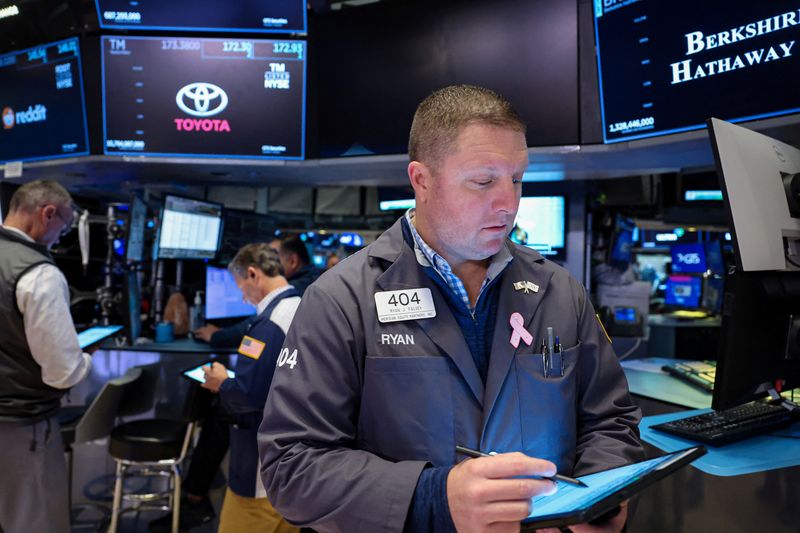Tech stocks drag on S&P 500, Nasdaq after inflation data
By Johann M Cherian and Purvi Agarwal
(Reuters) - The S&P 500 and the Nasdaq edged lower on Wednesday, weighed by a decline in technology stocks, while investors focused on the Federal Reserve's next move following an in-line inflation reading.
A Commerce Department report showed the Personal Consumption Expenditure index, the Fed's preferred inflation gauge, rose 2.3% in October on an annual basis, in line with economists' estimates. However, it remained above the central bank's 2% target.
Traders still expect a 66% chance the Fed will lower borrowing costs by 25 basis points at its December meeting, according to CME's FedWatch.
At 10:15 a.m. the Dow Jones Industrial Average rose 105.77 points, or 0.23%, to 44,964.85, the S&P 500 lost 12.62 points, or 0.21%, to 6,009.01 and the Nasdaq Composite lost 127.19 points, or 0.66%, to 19,048.39.
Most megacaps fell, with Nvidia (NASDAQ:NVDA ) down 2.5%, while Microsoft (NASDAQ:MSFT ) lost 0.6%. Losses in these stocks brought the Information Technology sector down 1.1%, as yields on shorter-dated Treasury bonds recouped some losses after the PCE data.
Dell (NYSE:DELL ) and HP (NYSE:HPQ ), which fell 10.5% and 10.1%, respectively, after downbeat quarterly forecasts, added to declines and were the top losers on the benchmark index.
The Russell 2000 index was up 0.7%, while the blue-chip Dow was buoyed by gains in healthcare and financial stocks.
Data earlier in the day showed the economy grew at a solid clip in the third quarter, while weekly jobless claims fell again last week, keeping the door open to another interest-rate cut from the Federal Reserve in December.
"Inflation has proven to be a little stickier than the Fed would have liked, which may give them pause with respect to cutting rates," said Scott Welch, chief investment officer at Certuity.
"There are questions around the effects of Trump's stated tariff policy, which, if implemented could be pretty inflationary and so the Fed is going to have to balance itself between the economic data and the incoming administration's policy agenda."
Minutes from the Fed's November meeting, released on Tuesday, showed policymakers were uncertain about the outlook for interest-rate cuts and how much the current rates were restricting the economy.
Concerns include U.S. President-elect Donald Trump's proposed tax cuts and tariff policies, including his latest stance on imports from Mexico, Canada and China, which could push up prices, spark a trade war and weigh on growth globally.
The benchmark S&P 500 is on track for its biggest one-month rise in a year and its sixth month of gains out of seven, as markets price in the probability of Trump's policies benefiting local businesses and the overall economy.
Workday (NASDAQ:WDAY ) lost 9.6% after forecasting fourth-quarter subscription revenue below expectations, hit by weaker client spending on its human capital management software.
Advancing issues outnumbered decliners by a 2.88-to-1 ratio on the NYSE, and by a 1.7-to-1 ratio on the Nasdaq.
The S&P 500 posted 74 new 52-week highs and no new lows, while the Nasdaq Composite recorded 99 new highs and 37 new lows.
Source: Investing.com
